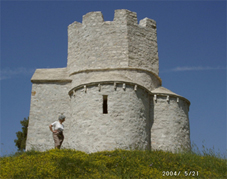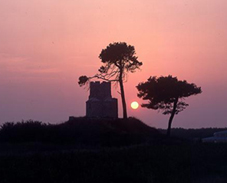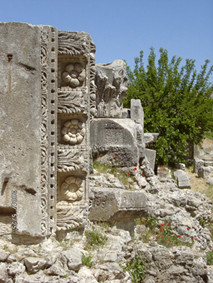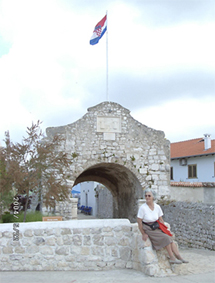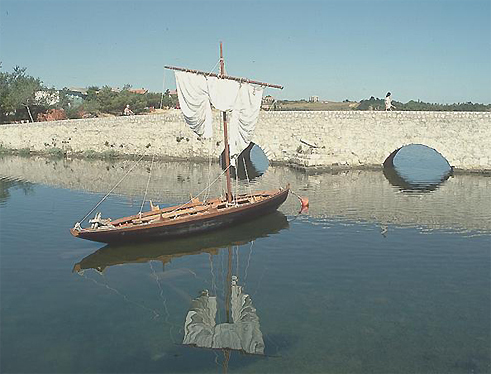N I N
The first political seat of Croatia about the year 800
Zvonko
Springer, Salzburg, Austria, 1999
on this web by kind permission, 2005
We
have booked an apartment at the village Privlaka for one week at the
end of May. We left Zagreb driving
on the motorway up to Karlovac turning of to the main road to Plitvice
as the new highway towards Split was
not completed yet. The “Licka kuca” (Lika House) was open
after one year of thorough renovation so we enjoyed a fine lunch there.
The rustic ambient remained almost the same but we missed the smoked
wood plank’s walls of old interior. Leaving Plitvice we had to
detour at Korenica on a rather steep and narrow road with many curves
(Ljiljana counted some 90 of) to get back on the main road at Udbina.
Soon
after we reached the new motorway and the tunnel of Rok constructed
through the Velebit Mountain.
After some 8km driving through the tunnel from end to end one comes
out below the Velebit’s peak of Mali
Alan. Coming out of it you get a splendid
view below on the Velebitski Kanal (Channel), Novigradsko more and
the Island of Pag as
well as Zadarske Ravni (Plains of Zadar) in front of you. Descending
the motorway’s long stretched serpentines we turned of it near
Posedarje to carry on a local road to Nin and to Privlaka some 3km
away only.
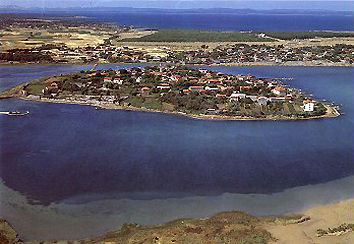
The southward
aerial view of the island with the City of Nin.
Privlaka
is located at the western tip of the Zdrijac peninsula some 20 km northwest
of Zadar. Opposite to Privlaka is the Island of Vir that
attracts some 70.000 tourists per annum. The heavy traffic and the
tourists’ moves to and fro Vir cause lot of disturbance to the
people of Privlaka during the holiday season. The accommodation In
Privlaka is possible mostly in private apartments or in small hostelry
and at two campsites. People here live of agriculture and viticulture
for ages as this region was somehow isolated for many years in the
near past. The tourist trade got to these places after the end of the
Home-war only. The plains have a pleasant climate but when the “bura” (the
northerly wind) gets over the Velebit it gets rather turbulent and
nasty. We got a proper bura for one night only but it was quite impressive.
The next day we drove to Zadar
as I was anxious to see how the city developed since my last
visits there in 1950s. Zadar ancient buildings of the old city
and the harbor structures were severely destructed by retreating
Germans forces in 1944. During the 1950s I worked as the consultant
for the Institute of Buildings
Research and looked after the structural
salvage of damaged Roman and old Croatian buildings. On our way
to Zadar soon after the road junction leading to Nin we noticed
a little church on an earthen hill amidst of the Prahulje plain.
We had to stop coming back from Zadar and trailed on a furrowed
path for some 100m to get close to the earthen hill some jutting
some 10m over the surrounding field. The grassy hill was easily
ascended but found the church’ only door locked.
At left
St. Nicolas Church in the Prahulje field near Nin on the day
of our visit and at the sunset at right .
(The picture is from URL: http://www.nin.hr)
The St. Nicolas’ Church
is the only preserved example of Romanesque architecture with the
central ground-plan and the cross-ribbed vault. The church dates
from the end of 11th and early 12th century. According “The
history of the City of Nin” seven Croatian kings were crowned in Nin. On
that occasion the crowned ruler would arrive riding with his entourage
to the church of St. Nicolas where he introduced himself the assembled peoples.
The king would point with his pulled out sword to the four sides
of the World.
The following
days we visited the City of Nin some 17km
northwest of Zadar few times. Nin is a coastal town in the south
of the Nin Bay on the Zdrijac peninsula
and has a population of about 1,700. The old town had been built-up
on a low alluvial peninsula that was converted into an islet by
a canal dug in the 14th century. It is connected with the mainland
by two small bridges: one of which is for pedestrian use only where
the other one on north side provides the access for the vehicles.
On that side are several shallow evaporation basins for the salt
production.
At left the ruins of Roman temple from 1st century
AC. At right the Main Gate that is the south exit of Nin .
On our way
back we passed the post office, the bank, several small shops,
a few inns of which we choose the small restaurant “Tomislav” as
our favorite eating place in Nin. Passing by the parish church
we came upon the central square in background of which rose the
tall black monument in that we recognized the bishop Grgur Ninski
(Gregory of Nin) instantly. The bronze sculpture is a work of Ivan
Mestrovic who gave his first sculpture to the cities of Varazdin
(1931) and Split (that is more monumental
but not alike the original). In Nin the one sculpture was erected
on the occasion of 900th anniversary of the chart issue (“Mare
nostrum”) by the Croatian king Petar Kresimir IV in 1069.
 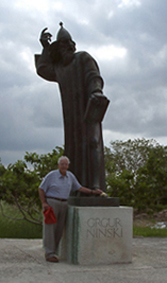
At left
the old front of the parish church and Zvonko confronts the monument
of bishop Grgur Ninski at right.
On the other side
of the square amidst a lawn stands the Church of St. Cross that is the smallest Cathedral in the World. Next
to it is the recently opened Museum that contains many essential
exhibits of Enona alias Nin of a long history. However the oldest traces originate in this region
from the Palaeolithic and the first settlement dates from the Neolithic.
The tribe of Liburnians founded the first colony of Enona during
the 9th century BC. Enona was one of the Liburnian Municipality to that the Roman authority entitled the status of
a Municipium Aenona later. By end of the 7th century Nin
became the first Croatian administrative, cultural and religious
seat. Later the Franks enforced the Christianization of
the newcomer Croats in their sphere after they crushed the rebellion
under Duke Ljudevit in 823 finally. After the division of the Frankish Kingdom in 843 their influence declined over the Croats.
The baptismal font
of Prince Višeslav is found in Nin that was the first political
seat of Croatia. At the edge of the six-sided font the last sentence
on the inscription reads: “This act (baptismal) was devout done by a
priest John at a time of Prince Višeslav to the honor of St. John the Baptist, to speak
for him and his protégés.” According the historians the Prince Višeslav
ruled around 800 year. Thus the font testifies about the time of
baptizing of the Croats. The missioners Cyril and Methodius came
to Croatia from Constantinople in 863 and they introduced the old church Glagolotic
Script to the Croats. That script was used for the liturgical texts
all over Croatia since.
In 924 the Župan
of Nin Tomislav (a district governor) was crowned as the King of
the Croats by the legate of Pope John X. The
bishop Grgur from Nin had the leading church position in Croatian
state then. On one of the church synods the archbishop from Split took over
the ruling of all Dalmatian dioceses placing itself under the Rome authority. Bishop Grgur got
the Skradin diocese but by the synod’s decision it was forbidden
old Slavic language in the liturgy too. As the priests were literate
in Latin one followed the western liturgy in Slavic church language
with Croatian details instead. Thus one saved the Croatian Glagolitsa
to become the cultural heritage as people’s language in the
liturgy and the literature to be replaced by the living language
in the Middle Ages.
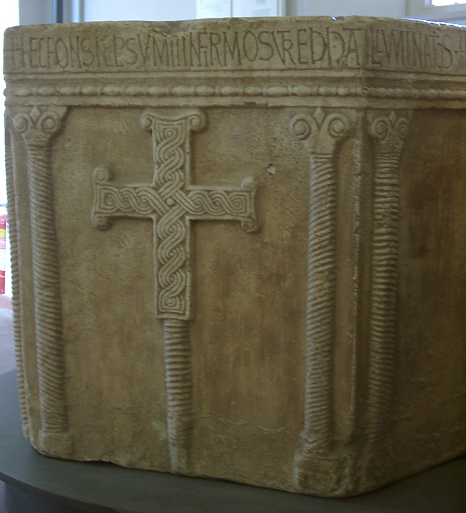
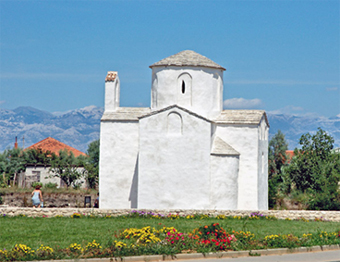
The Baptismal
Font of Prince Višeslav with an inscription around the six-sided
font and the Church of St. Cross
after recent reconstruction
(The picture is from URL: http://www.nin.hr/).
The small
church of the Holy Cross from the 9th century is the most important
pre-Romanesque preserved monument of the old Croatian architecture.
A cupola covers the center of the cross-shaped ground plan
of the church named “the smallest cathedral of the World”.
The name of a Croatian župan Godecaj is extolled on the
adorned stone lintel of the small church. There is another
inscription “Branimir Duke of the Croats” that
originates from a former church of St. Michael around 888. The present parish church of St. Anselm has been built on the location of an old Romanesque-
Gothic cathedral. Its treasury keeps the reliquaries from around
800 AD.
Nin impressed us mostly with
its concentration of historical artifacts in such a small place.
During our 7-day stay we visited this tiny town several times.
One could marvel of its bulwark that seems to be almost intact
as it had not have to repel any enemy attack. We visited the
new museum that has on display many objects of recent findings
and some reports about ongoing excavations. One really has to
ponder about the ancient Croatians who arrived to these regions
some 13 century ago. There are so many of evidences of the Croatian
early history concentrated in this region that certainly you
want to learn more about it. I may consider composing a web-site
about the history of City of Nin and to include more of my
pictures going with more historical particulars.
The reconstructed replica of
an old Croatian boat.
(The picture
is from URL: http://www.nin.h).
About
the Literature:
The author compiled and/or
translated the text from
various sources mainly from: http://www.hr./darko/etf/et112.html or http://www.croatianhistory.net
Certain pictures are from: http://www.nin.hr and www.zadar.hr
DISCLAIMER : On URL: http://www.cosy.sbg.ac.at/~zzspri/ published
pages are originals and authorized by copyright of Zvonko Z. Springer, Salzburg
1999.
Email Zvonko Springer at : zzspri@aon.at
Croatia - its History, Culture and Science
|
